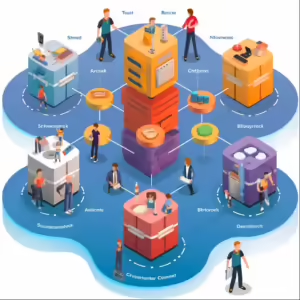ReST Services: Introduction to the world of web communication
In today's digital world, ReST Services (Representational State Transfer Services) play a central role in the way applications and systems communicate with each other. They are a fundamental part of many online services that we use every day. This article attempts to explain ReST Services in a simple and understandable way.
What are ReST Services?
Think of ReST Services as a form of communication between different computer systems on the Internet. Just as people use different languages to communicate with each other, computers use ReST Services to exchange information and perform tasks.
How do ReST services work?
ReST Services use the same protocol that is used on the web – HTTP (Hypertext Transfer Protocol). When you visit a website, your browser sends an HTTP request to retrieve the page. ReST services work in a similar way: They send requests to a server to obtain certain information or to carry out actions.
For example, when you open a weather app on your smartphone, that app could send a ReST request to a server to get the latest weather data.
REST (Representational State Transfer) services have become a fundamental building block in the development of modern web applications. They provide a simple and efficient way to enable client-server communication in distributed systems. This article explains the concept of REST Services, how they work, benefits, and typical use cases.
REST Services are an architecture for creating web services that follow REST principles. REST is an architectural style defined by Roy Fielding that uses standardized HTTP methods to communicate between client and server. REST services work with resources, with each resource identified by a URL.
Core principles of REST Services
- Unified interface: Use standardized HTTP methods (GET, POST, PUT, DELETE) to interact with resources.
- Statelessness: Every request from a client to the server contains all the information necessary for processing.
- Resource Orientation: Data and functionality are represented as resources accessed via URLs.
- Representation: Resources can be represented in different formats such as JSON or XML.
Benefits of REST Services
- Scalability: Statelessness and simple structures support scalability.
- Ease and Flexibility: Easy implementation and wide compatibility with various platforms and languages.
- Performance: Efficient client-server communication can improve performance.
- Accessibility: Use of standard web technologies makes REST services easily accessible.
Typical use cases for REST services
- Web APIs: REST is often used to create APIs for web applications.
- Microservices architectures: REST services are ideal for communication between microservices.
- Mobile Applications: Providing backend services for mobile apps via REST APIs.
- Integration of third-party systems: Connection of external services and systems via RESTful APIs.
Challenges when using REST services
- Security: Implementing security measures such as authentication and authorization is crucial.
- Managing State: Although REST is stateless, managing user sessions can be challenging.
- Data transfer: Performance can be affected with large amounts of data.
Conclusion
REST services play a central role in modern web development. Their simplicity, flexibility, and scalability make them a preferred choice for building web APIs and supporting microservices architectures. By adhering to REST principles, developers can create powerful, efficient, and maintainable web services that meet the needs of modern web applications.






